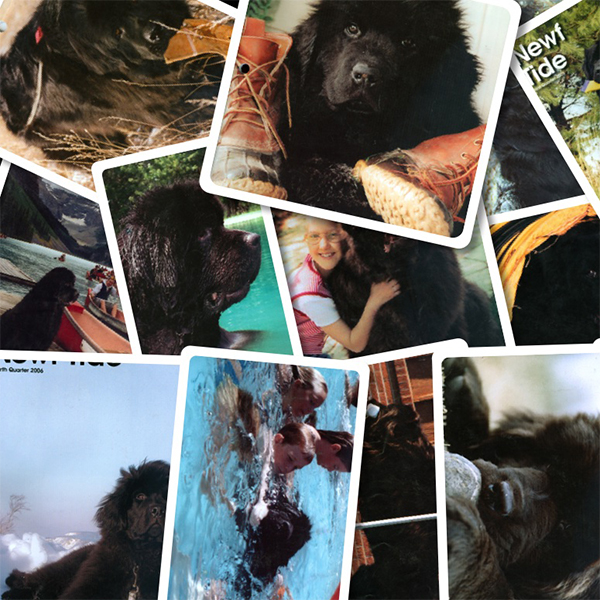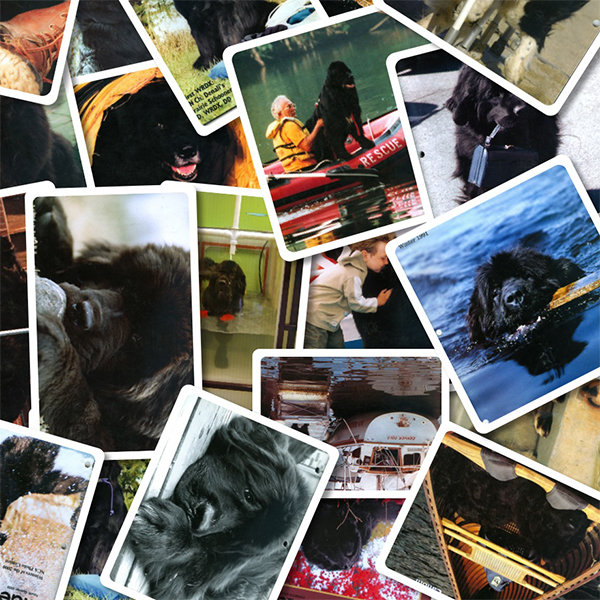
Our guest columnist is Newfoundland owner and trainer Rebecca Stanevich.
Tiptop’s Flo Jo, a certified search and rescue dog, is in training to find drowning victims. When a trained dog makes a “find”, the divers can be put in and know that a body will usually be found within a 50-ft circle. The body can be recovered much more quickly and more safely than by using divers alone. Flo’s training started by having her find members of our dive team who were underwater. When the boat with the dog was positioned over a diver, the diver surfaced right under Flo, along with her favorite treats. Because Flo was already skilled in searching for people, she quickly figured out the new game: Find the scent of the dicer and he’ll bring you a treat! My command to Flo is “Find the Fish!” “Find” is her search command, and “Fish” was suggested by my instructor to let Flo know that she will be searching for someone under the water.
Flo was introduced to cadaver scent using a variety of scents. There is a chemical pseudo cadaver scent that is safe because there are no biohazard problems to consider. Other training material included by own blood, teeth and hair, as ell as items that have been in contact with cadavers such as clothing, or dirt if they died outside, or pieces of furniture if they died indoors. We take great care to handle this material using the precautions taught in our biohazard classes. Flo quickly learned to ignore hot dogs and candy (she has a sweet tooth) and other scents, and alert only on the cadaver scent. I taught this using a clicker, only “clicking” when I let her smell the cadaver scent. Then I placed the different scent containers in cement building blocks, walked her past each block, and asked her to “check it out”, a command she knows from her airscenting work. When she went to the block with the cadaver scent in it, she got a “click” and a treat.
When I was sure she knew what the cadaver materials smelled like, we went back to the water. Using a system that gives the dog a visual clue and a reward, a line is run from the shore through an anchor and up to a buoy and scent cage. The scent is placed in the cage and someone on shore pulls the line until scent cage and buoy are underwater. The scent travels from the scent cage up to the surface. The dog is in the boat and the boat begins a search pattern – weaving through the water. Beginning dogs are taken directly over the scent, the shore person releases the line and the buoy pops out of the water. Since search dogs typically have tremendous play drive, a toy popping up in front of them is just irresistible. They are rewarded just for finding the scent, plus the dog gets a favorite toy or treat.
Now that Flo understood that she was looking for scent underwater, we began “building an alert”. This is a behavior I can recognize that means she found the proper scent. I prefer to use whatever the dog does naturally. Flo seemed to be crouching over the bow of the boat when in heavy scent – all the easier to grab the buoy! So whenever we were in scent and she crouched, she immediately got her food reward. It took Flo and I a year to develop a solidly trained alert, and for me to recognize the ways she indicates we are moving into and out of a scent.
Flo and I will continue to train to achieve operational status. Hopefully, by the time you read this, she will be a certified water cadaver dog.- R.S.

